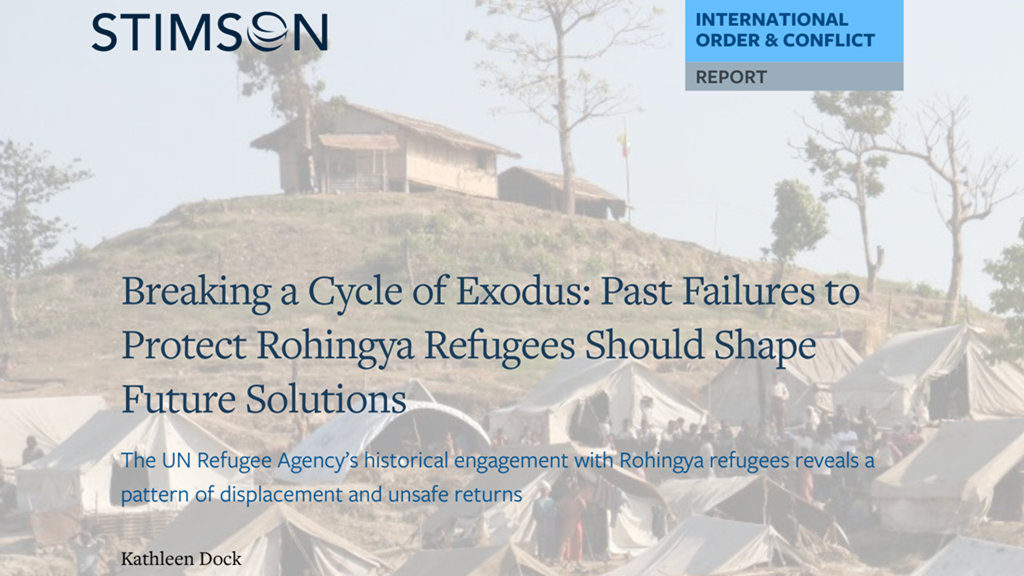
Breaking a Cycle of Exodus: Past Failures to Protect Rohingya Refugees Should Shape Future Solutions
Category: Reports Publisher: Kathleen Dock Published: 1 June 2020 DownloadSummary:
In August 2017, the international community watched as hundreds of thousands of Rohingya civilians fled their homes in Rakhine State following a brutal crackdown by the Myanmar military, which included crimes against humanity and acts of genocide. Over one million Rohingya refugees now live in camps in Cox’s Bazar, Bangladesh.
This exodus is not without precedent. In 1978 and from 1991-1992, hundreds of thousands of Rohingya fled to Bangladesh following similar violence and persecution by the military. In both the 1970s and the 1990s, the majority of these refugees returned to Myanmar within a few years. These repatriation operations were premature and unsafe despite the presence of the UN Refugee Agency (UNHCR), which is mandated with refugee protection.
This report looks at today’s crisis through the lens of these earlier displacements and identifies factors for the international community and United Nations to consider that contributed to a cycle of exodus in the past. This work is based on original research in the UNHCR archives, which reveals that in both the 1970s and the 1990s, UNHCR was unable – and in some cases unwilling – to carry out a safe, voluntary, and dignified repatriation. This research aims to identify some of the reasons how and why previous protection efforts were insufficient in order to assess how key actors can more effectively respond to the current crisis.
Findings
Pressure on UN agencies will grow.
Currently, UNHCR and the government of Bangladesh remain committed to only carrying out a repatriation operation that is safe, voluntary, dignified, and sustainable. However, there is a gap between how the international community and multilateral agencies have translated norms and principles, such as voluntary repatriation, into practice in the past.
In both the 1970s and the 1990s, there was significant pressure from the government of Bangladesh to return the refugees to Myanmar. This pressure intensified as the crises went on, becoming a rationale for UN agencies to promote the return of refugees although the underlying causes of displacement in Myanmar remained unaddressed.
Political support is needed to maintain protection principles.
UN agencies can only operate in a country with the consent of the host state. As such, there is often a tension for humanitarian offices between maintaining access to a country and upholding a mandate that may call into question the actions of that government. In the 1970s and 1990s, UNHCR made choices that prioritized relationships with the governments of Bangladesh and Myanmar over explicitly addressing human rights and protection concerns facing refugees.
The shortcoming of this approach, however, is that protection practices and norms, such as individually interviewing refugees prior to return, were often sidelined in favor of maintaining these relationships. Local UNHCR offices need greater political support from UNHCR headquarters and from UN member states to counterbalance and push back against a government’s coercive tactics while still maintaining essential access.
Disjunction within UN agencies weakens protection efforts.
In the past, different priorities and incoherent communication between UNHCR offices in Bangladesh, Myanmar, and Geneva also contributed to discrepancies in protection policy on the ground. The hierarchical structure of the agency meant that policy concerns in Geneva superseded reservations raised by field staff. In these cases, the decision to push for early repatriation despite protection concerns came from the top.
Alternatives to repatriation need consideration.
Returning refugees to unchanged conditions from which they fled can increase the likelihood of another future exodus. This pattern has done little to create permanent solutions for the Rohingya or Bangladeshi host communities. Repeating this history could injure civilians, further burden host nations, and harm UN and international efforts to support lasting peace – the costs are significant in lives, dollars, and effort.
For the current crisis, several factors – such as the text of the repatriation agreements, conditions in Bangladesh and Myanmar, and UN engagement – are reminiscent of past trends that contributed to premature and unsafe returns. Increased international attention and elevated refugee engagement are promising trends for a different outcome, but the international community still hails the return of refugees as soon as possible as the ideal solution to the crisis. A new approach is critical.
Key actors, and in particular, UNHCR, can adopt practices that avoid past mistakes and learn from them. Pursuing hasty repatriation in lieu of real change in Rakhine State was not a sustainable solution in the 1970s or the 1990s — and it would not be a sustainable solution today.
Back

